Archives Experience Newsletter - June 14, 2022
A Helping Hand
World War I was “The War to End All Wars,” or so it was supposed to be. If not for the flawed Treaty of Versailles, the Great War could have been the last land war in Europe. But the treaty was more about punishing Germany than rebuilding a continent ravaged by war, which fueled German resentment and eventually led to World War II.
To understand the importance of the Marshall Plan that followed World War II, it’s helpful to understand the scale of the war’s destruction. In October 2016, documentarian and data visualization expert Neil Halloran released a short film called The Fallen of World War II. Halloran uses illustrations, depictions of soldiers, narration, and Archives images to paint a devastating picture of the human cost of World War II. It is overwhelming and heartbreaking, but it ends with a hopeful message: Europe experienced a “long peace” after the war that ended centuries of land wars and set a new standard for how a community of nations should interact.
This year, we celebrate the seventy-fifth anniversary of the catalyst for the long peace – the Marshall Plan. Conceived by Secretary of State George Marshall, the plan’s goal was to build back, rather than perpetuate Europe’s weakened state. This week’s newsletter gives readers some insights into this part of history from the stacks of the Archives.

Patrick Madden
Executive Director
National Archives Foundation
A Soldier and a Statesman
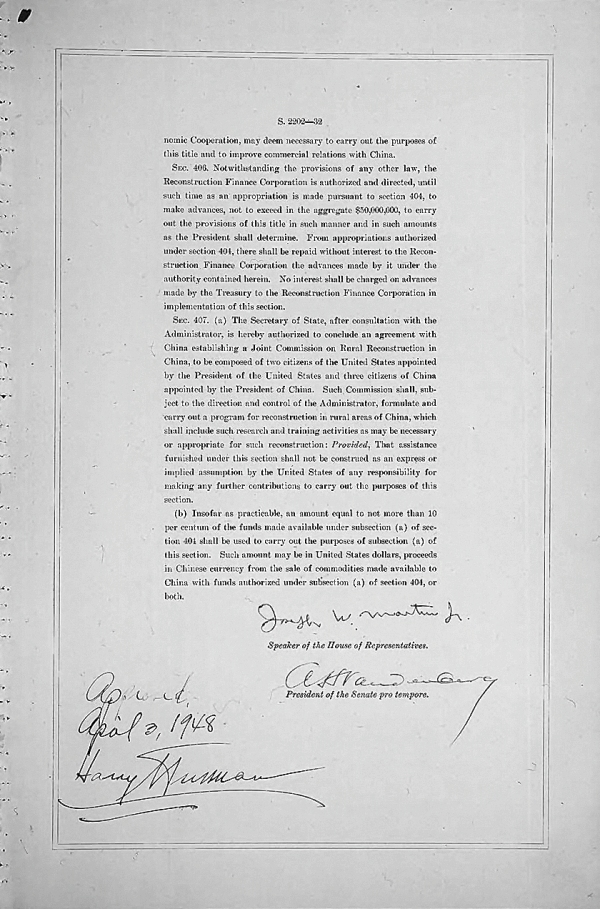
The Marshall Plan (Public Law 432) last page
When he was asked about his political leanings, George Catlett Marshall often said that his father was a Democrat and his mother was a Republican, but he was an Episcopalian. That description proved most accurate when he was called upon to carry out the most complex and important charge of his life.
Marshall was born in Uniontown, Pennsylvania on December 31, 1880, to George Catlett Marshall and Laura Emily Bradford. From a young age, he wanted to be a soldier, but he realized he was unlikely to receive a congressional appointment to a military academy, so he set his sights on attending the Virginia Military Institute (VMI). His mother sold several parcels of land to pay for his education. Marshall thrived at VMI. Upon his graduation, he applied to and was accepted into the U.S. Army with the rank of second lieutenant in 1902. He then married Elizabeth Carter “Lily” Coles, whom he had met while he was at VMI, and immediately shipped out for the Philippines.
This was the first of a long series of deployments. After the Philippines, Marshall served at Fort Leavenworth in Kansas, in the Philippines again, at the Presidio in San Francisco, and then, at the start of World War I, at Governor’s Island in New York. He was then sent to France, where he caught the attention of John J. Pershing, commander of the American Expeditionary Force. Marshall distinguished himself on the battlefield and was awarded the Citation Star, the precursor of the Silver Star, for gallantry during the Battle of Cantigny. In 1919, Marshall became an aide-de-camp to Pershing, who greatly valued his advice and organizational expertise.
Between the wars, Marshall climbed the ranks, becoming acting Chief of Staff of the U.S. Army in 1939. When World War II began, the Army had only 189,000 troops, and Marshall had to rapidly expand and modernize the force. He was instrumental in choosing or recommending many of the U.S. generals who served during the war. He also helped plan the 1945 invasion of Europe.
After the war, Marshall served President Harry S. Truman as Secretary of State, and it was in this capacity that he gave birth to what became the Marshall Plan. His experience of World War I and its aftermath proved critical to his understanding of how critical it was that the United States help both its allies and its former enemies recover from the ravages of the most devastating ground war ever fought on the planet. Marshall understood, to a degree that many Americans did not, that the vicious punishments the Treaty of Versailles had inflicted on Germany at the end of World War I contributed to that nation’s crippling poverty, the consequent resentments many Germans felt toward the rest of Europe, and the resulting rise of Adolf Hitler. He also recognized that the United States could not afford to retreat into isolationism again.
At the end of World War II, Europe was pretty much in shambles. Major cities had been destroyed by continuous bombing, transportations systems had been demolished, millions of people were living in refugee camps, and agricultural production was at a standstill, exacerbated by a disastrous drought. Consequently, food shortages across the continent were profound.
Although there had been some conversation among the Allies about helping to rebuild European economies, in March of 1947, U.S. Secretary of State George Marshall was attending the Moscow Foreign Ministers Conference when he realized that Moscow apparently had no intention of contributing to the plan. He foresaw that the USSR intended to expand its influence throughout Europe and that it planned to do so by stalling about coming forward with any aid. “The patient is sinking,” Marshall said, “while the doctors deliberate.” He decided that the rest of the participating nations had no option but to go ahead with their initiative.
Back in the U.S., Marshall gathered a team of experts and gave them two weeks to come up with a plan to help Europe recover. He announced their plan in a major speech at Harvard University on June 5, 1947. “The modern system of the division of labor upon which the exchange of products is based is in danger of breaking down….,” Marshall told his audience. “It is logical that the United States should do whatever it is able to do to assist in the return of normal economic health in the world, without which there can be no political stability and no assured peace. Our policy is not directed against any country, but against hunger, poverty, desperation and chaos.”
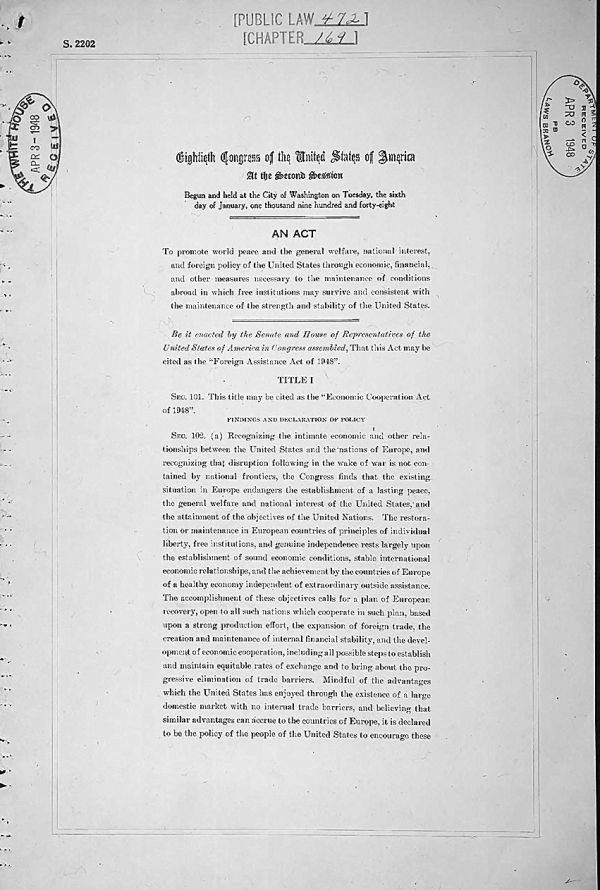
Learn more about the Marshall Plan Speech
Source: Marshall Foundation
In the speech, Marshall insisted on several key points for the plan: the United States would pay for it, but the Europeans would plan it; all European countries could take part in it; the plan would have a specific and limited timeline; people’s physical needs would be taken care of first, and then infrastructure would be rebuilt; and all participants would have to trade with each other equally.
Sixteen European nations worked out the details of the plan during the summer of 1947. Marshall and the State Department then began working to persuade Congress to approve the plan. Even though George Marshall did not create the plan, and in fact took no credit for its details, President Truman suggested the plan be named the “Marshall Plan” because of Marshall’s reputation for unquestionable nonpartisanship and integrity. Congress approved the plan in March 1948, and the President signed it into law in April.
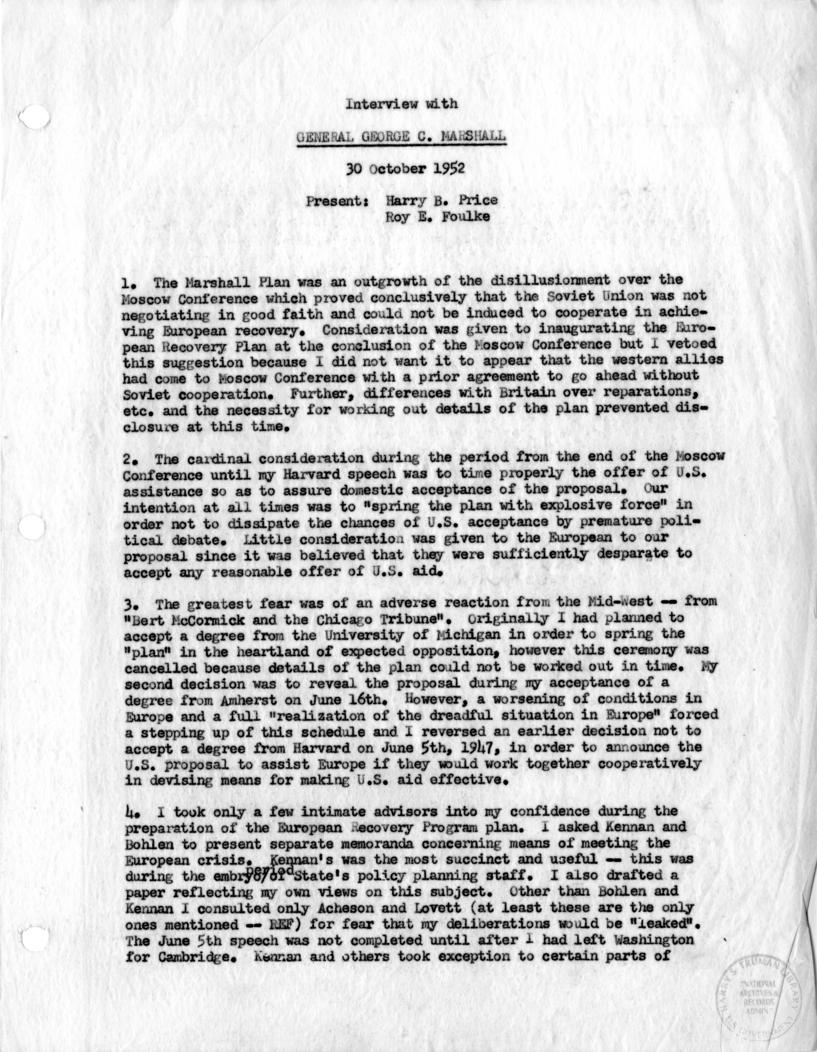
Interview with George Marshall – Full Transcript
Source: Truman Library
Funding was distributed roughly on a per capita basis on the theory that after meeting immediate humanitarian needs, rebuilding industry was the next pressing priority. Thus, the United Kingdom received just over a quarter of the total U.S. dollars spent on the Marshall Plan, and France received about 18 percent. These two nations were both allies of the U.S., but the plan deliberately did not distinguish between the recipients on that basis. Thus, West Germany received the third-largest amount of aid under the Marshall Plan, about 11 percent of the total aid distributed, in large part because the administrators recognized the necessity to rebuild the German economy.
Other nations that received aid under the Marshall plan included Austria, Belgium and Luxembourg, Denmark, Greece, Iceland, Ireland, Italy and Trieste, the Netherlands, Norway, Portugal, Sweden, Switzerland, and Turkey.
In 1953, George C. Marshall won the Nobel Peace Prize in recognition of his efforts on behalf of the post-war recovery of Europe.
A Cold Refusal
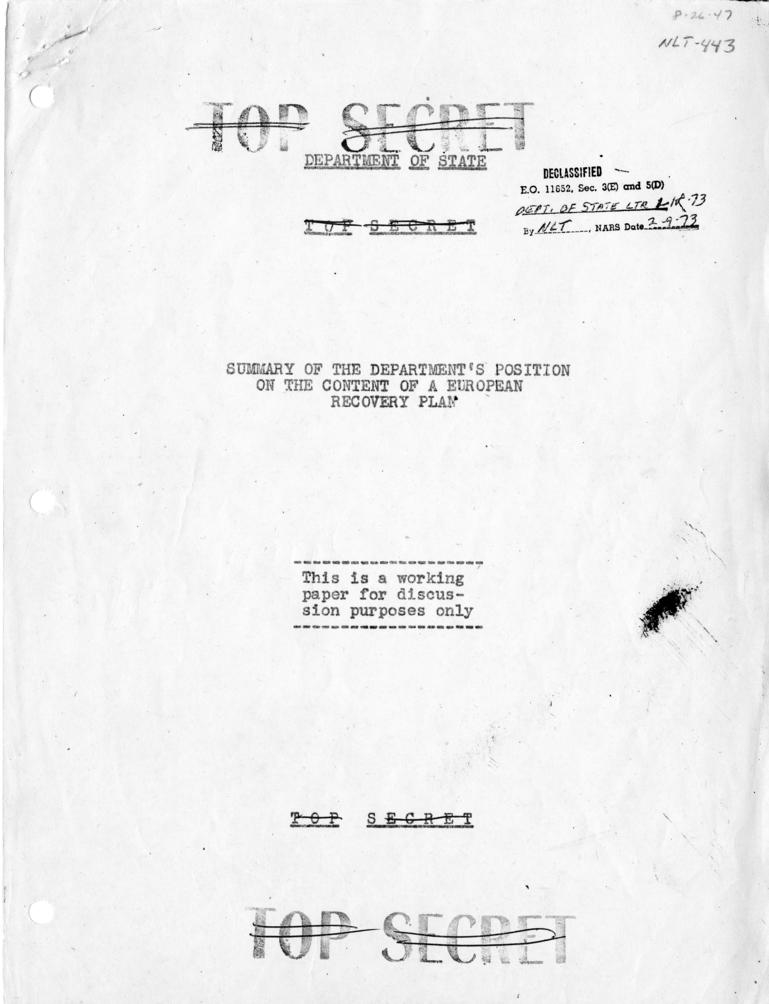
State Department Memo on the Marshall Plan
Source: Truman Library
Practically from the moment that George Marshall gave his speech on the steps of Memorial Church at Harvard University outlining what would within a year come to be called the “Marshall Plan,” the authorities of the USSR were maneuvering to sabotage it. Soviet Foreign Minister Vyacheslav Molotov had stated at the Paris Peace Conference in October 1946 that the introduction of American aid into Eastern bloc countries would enslave them to capitalism. Stalin initially hoped that he could undercut the Marshall Plan, but when he realized that its provisions included that all nations had to cooperate economically and that West Germany would also receive aid, he realized that the Soviet Union would not be able to exercise undue influence over that nation.
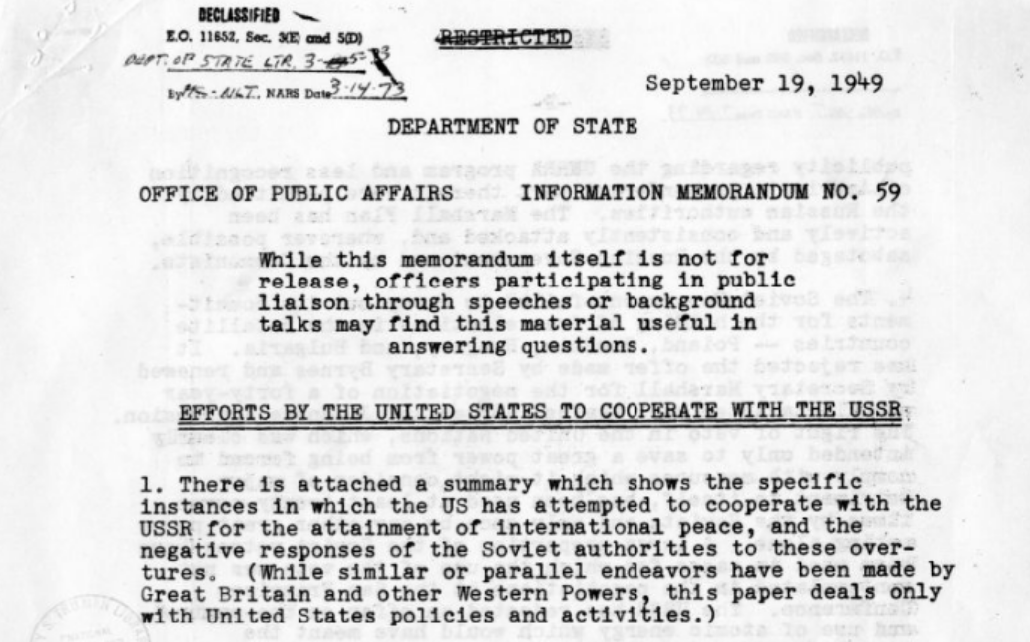
Department of State, Office of Public Affairs, Information Memorandum Number 59
National Archives Identifier: 214916548
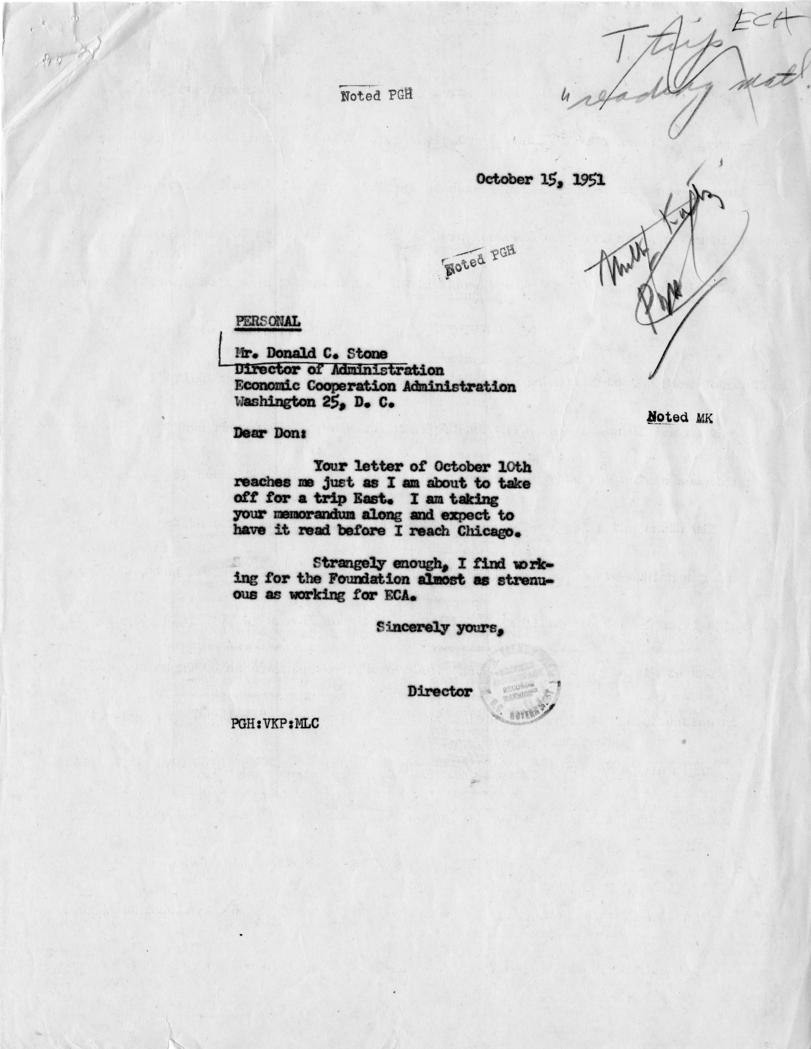
Security Implications of the Marshall Plan
Source: Truman Library
Consequently, the USSR refused to accept any aid under the Marshall Plan or to allow any of its Eastern Bloc affiliates to accept any. The sole exception was Yugoslavia, which in 1948, under the leadership of Josip Broz (Tito), broke away from the USSR and became an independent communist state and thereafter requested and received aid under the Marshall Plan.
The initiation of the Marshall Plan in Europe in effect was the beginning of the Cold War, in which the United States and the USSR faced off against one another via a series of proxies, including the Berlin Blockade, the Chinese Civil War, the Korean War, the Cuban Missile Crisis, and conflicts in Africa and Asia. The Cold War did not end until the dissolution of the Soviet Union in December 1991.
Unequal Treatment
Following the atomic bombings of Hiroshima and Nagasaki, Japan unconditionally surrendered to the Allied Forces on August 15, 1945. General Douglas MacArthur took control of the Supreme Command of Allied Powers (SCAP) in September and began rebuilding Japan.
MacArthur’s work bore some resemblance to the Marshall Plan, although the initial phase was more devoted to punishment and reformation than the European plan did. During the first two years, SCAP dismantled the Japanese military, convened war crimes trials, and prevented former military officers from holding political office. The command also instituted land reform on behalf of tenant farmers, attempted to install a free-market economy, elevated the power of the parliament while downgrading the status of the emperor, and did away with the nation’s right to wage war.
An economic crisis in 1947 and 1948 began to make communism look more attractive to some Japanese citizens. China, of course, had by then become a communist nation, and a domestic communism movement was gaining a foothold in Japan, so SCAP changed course and began to concentrate on rebuilding the Japanese economy. The beginning of the Korean War also made Japan the perfect launching pad for U.S. military operations in Korea.
By 1950, SCAP began to work out the terms for ending the occupation of Japan. The final agreement allowed the United States to maintain military bases in Japan, and the U.S. government promised Japan a bilateral security pact. In September 1951, fifty-two nations met in San Francisco to discuss the treaty, and ultimately, forty-nine of them signed it. The USSR, Poland, and Czechoslovakia refused to sign, objecting to the requirement that they not do business with the People’s Republic of China.
Listen to Allied response to Japan’s surrender proposal
(15 minutes 41 seconds)
National Archives Identifier: 178209422

Covert Aid
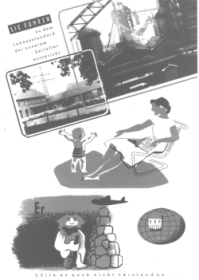
Poster to publicize aid to European Countries
President Harry S. Truman established the Central Intelligence Group on January 22, 1946. In 1947, it became the Central Intelligence Agency (CIA), a civilian covert intelligence gathering agency that mainly provides intelligence to the President and the Cabinet.
The CIA received 5 percent of the funds from the Marshall Plan ($685 million over six years). It used the money to support student groups, labor unions, newspapers, and artists and intellectuals who were fighting against communist-backed organizations, not agents who worked in the USSR or Eastern Bloc countries. Most of those working on behalf of the pro-U.S. causes were critics, philosophers, writers, and historians.
One of the most notable anti-communist activities was the Festival of Twentieth Century Masterpieces and Modern Arts, which took places in Paris in 1952. The event was planned and supported by the Congress of Cultural Freedom, which was formed by the CIA. The festival’s goal was to demonstrate how the freedoms afforded by capitalism allowed maximum artistic expression. The Boston Symphony Orchestra was flown to Paris to perform pieces such as The Rite of Spring and music by composers John Cage, Gustav Mahler, Paul Hindemith, and Claude Debussy. This festival was so successful that an American journalist commented “the Boston Symphony Orchestra won more acclaim for the U.S. in Paris than John Foster Dulles or Dwight D. Eisenhower could have brought with a hundred speeches.”
Community of Nations
Since the Russian invasion of Ukraine in March, the Northern Atlantic Treaty Organization (NATO) has been in the news a lot. Formed in 1948, NATO is a military alliance created to guard against Soviet expansion and to encourage European integration.
NATO was not part of the Marshall Plan, but after the plan was in full swing, the USSR became increasingly alarmed about U.S. influence in Europe, particularly in West Germany. In the middle of 1948, Stalin blockaded West Berlin, which was controlled by the U.K., U.S., and France, but completely surrounded by East Germany. The Allied Forces responded by airlifting supplies into Berlin in a nearly yearlong effort that kept the population warm and fed and effectively forced the Soviets to back down from their position.
The experience, however, convinced the United States and its allies of the need for a military alliance that would guarantee the security of all its members. In April 1949, representatives from twelve countries signed the NATO alliance in Washington, D.C. Membership has since grown to thirty countries.
The key component of the treaty is Article 5: “The Parties agree that an armed attack against one or more of them in Europe or North America shall be considered an attack against them all….” Four countries that border Ukraine are members of NATO: Poland, Slovakia, Romania, and Hungary. This is critically important because it means that should Russia attack any of those nations in its war with Ukraine, the other members of NATO will be obliged to respond in kind.
Since the war in Ukraine began, two more nations that have long considered themselves neutral, Finland and Sweden, have applied for membership in NATO. The border between Finland and Russia is 830 miles (1,340 km) long.
(7 minutes 17 seconds)
National Archives Identifier: 23885
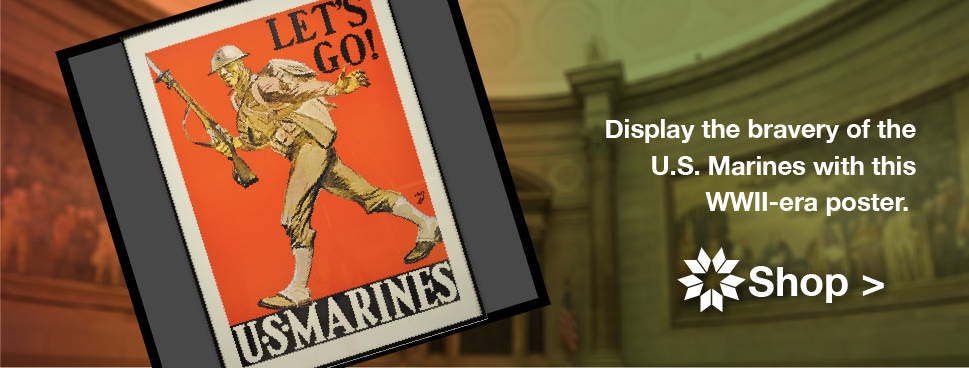
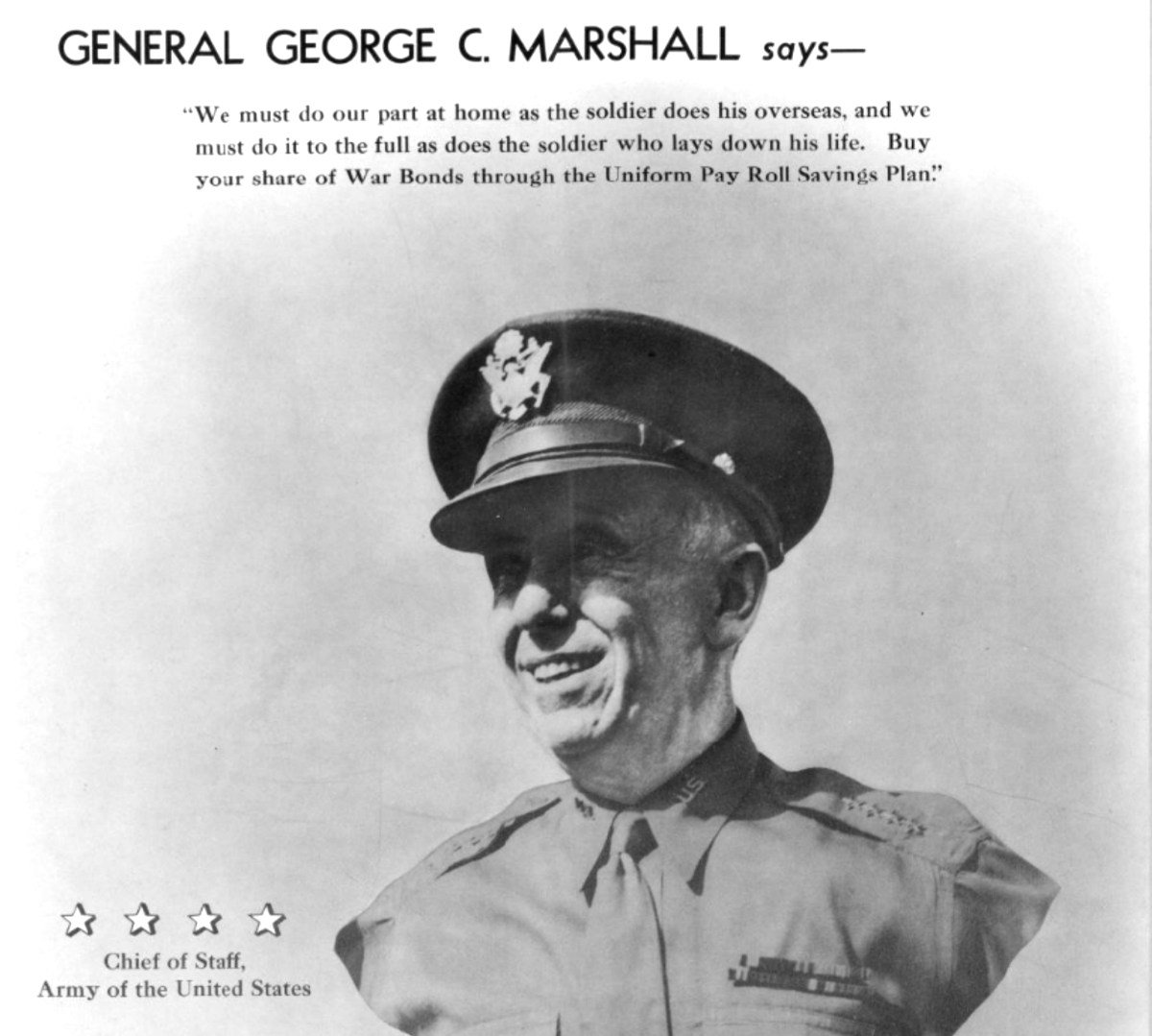




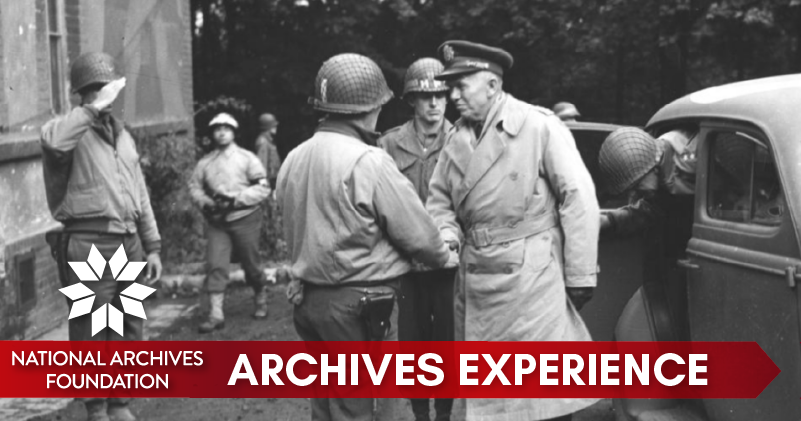






![Donzere-Mondragon Project - Refrigeration Plants in Southern France- NAI 19974591 [Donzere-MondrDonzere-Mondragon Project - Refrigeration Plants in Southern France- NAI 19974591agon Project] - [Refrigeration Plants in Southern France]- NAI 19974591](https://www.archivesfoundation.org/site/uploads/2022/06/ae-2022-06-14-a1-nai-19974591.png)













